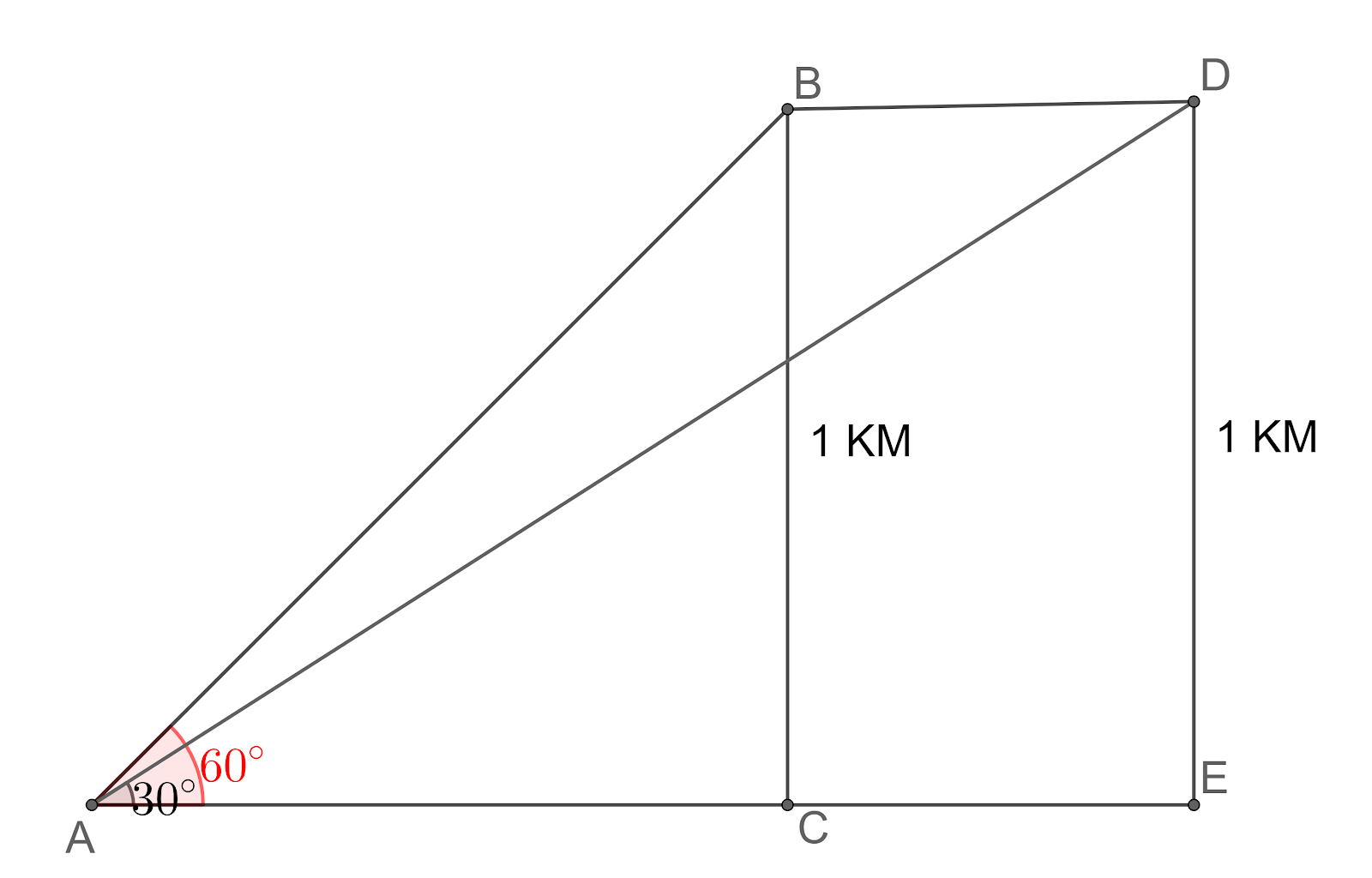
An aeroplane flying horizontally 1 km above the ground is observed at an elevation of ${{60}^{\circ }}$. After 10 s, if its elevation is observed to be ${{30}^{\circ }}$, then find the uniform speed of the aeroplane in km/h?
(a) $\dfrac{240}{\sqrt{2}}$,
(b) $240\sqrt{3}$,
(c) $240$,
(d) None of these.
Answer
465.3k+ views
Hint: We start solving the problem by drawing the given information to get a better view. We then find the total distance travelled by the aeroplane in the given 10 s using the diagram we just drawn. We then find the speed of the aeroplane by dividing the obtained distance with 10 s. We then use the fact that $1s=\dfrac{1}{3600}h$ to get the required value of speed in km/h.
Complete step-by-step answer:
According to the problem, we have an aeroplane flying horizontally 1 km above the ground which is observed at an elevation of ${{60}^{\circ }}$. We need to find the uniform speed of aeroplane in km/h if the angle of elevation is observed to be ${{30}^{\circ }}$ after 10 s.
Let us draw the given information to get a better view.

Let us assume that the aeroplane is at point B when the angle of elevation is ${{60}^{\circ }}$ and moves a distance BD after 10 seconds.
Let us first find the distance AC and AD.
From triangle ABC, we get $\tan {{60}^{\circ }}=\dfrac{BC}{AB}$.
$\Rightarrow \sqrt{3}=\dfrac{1}{AB}$.
$\Rightarrow AB=\dfrac{1}{\sqrt{3}}km$ ---(1).
From triangle AED, we get $\tan {{60}^{\circ }}=\dfrac{DE}{AE}$.
$\Rightarrow \dfrac{1}{\sqrt{3}}=\dfrac{1}{AE}$.
$\Rightarrow AE=\sqrt{3}km$ ---(2).
From the figure we can see that $BE=CD=AE-AB$.
$\Rightarrow BE=\sqrt{3}-\dfrac{1}{\sqrt{3}}$.
$\Rightarrow CD=\dfrac{3-1}{\sqrt{3}}$.
$\Rightarrow CD=\dfrac{2}{\sqrt{3}}km$.
So, the aeroplane travelled $\dfrac{2}{\sqrt{3}}km$ in 10 s. Using we get the speed of the aeroplane as $\dfrac{\dfrac{2}{\sqrt{3}}}{10}=\dfrac{1}{5\sqrt{3}}km/s$.
We know that the 1 hour = 3600 s. Using this we get $1s=\dfrac{1}{3600}h$.
So, we get speed of aeroplane as $s=\dfrac{\dfrac{1}{5\sqrt{3}}}{\dfrac{1}{3600}}km/h$.
$\Rightarrow s=\dfrac{720}{\sqrt{3}}km/h$.
$\Rightarrow s=240\sqrt{3}km/h$.
So, we have found the speed of the aeroplane as $240\sqrt{3}km/h$.
So, the correct answer is “Option (b)”.
Note: We should not stop solving the problem after finding the speed in km/s, as it is mentioned km/h in the problem. Whenever we are asked to solve this type of problems we need to draw the diagram first to get a better view. We have assumed that distance of aeroplane above the ground is not changing throughout the problem. We should not make calculation mistakes while solving this problem.
Complete step-by-step answer:
According to the problem, we have an aeroplane flying horizontally 1 km above the ground which is observed at an elevation of ${{60}^{\circ }}$. We need to find the uniform speed of aeroplane in km/h if the angle of elevation is observed to be ${{30}^{\circ }}$ after 10 s.
Let us draw the given information to get a better view.

Let us assume that the aeroplane is at point B when the angle of elevation is ${{60}^{\circ }}$ and moves a distance BD after 10 seconds.
Let us first find the distance AC and AD.
From triangle ABC, we get $\tan {{60}^{\circ }}=\dfrac{BC}{AB}$.
$\Rightarrow \sqrt{3}=\dfrac{1}{AB}$.
$\Rightarrow AB=\dfrac{1}{\sqrt{3}}km$ ---(1).
From triangle AED, we get $\tan {{60}^{\circ }}=\dfrac{DE}{AE}$.
$\Rightarrow \dfrac{1}{\sqrt{3}}=\dfrac{1}{AE}$.
$\Rightarrow AE=\sqrt{3}km$ ---(2).
From the figure we can see that $BE=CD=AE-AB$.
$\Rightarrow BE=\sqrt{3}-\dfrac{1}{\sqrt{3}}$.
$\Rightarrow CD=\dfrac{3-1}{\sqrt{3}}$.
$\Rightarrow CD=\dfrac{2}{\sqrt{3}}km$.
So, the aeroplane travelled $\dfrac{2}{\sqrt{3}}km$ in 10 s. Using we get the speed of the aeroplane as $\dfrac{\dfrac{2}{\sqrt{3}}}{10}=\dfrac{1}{5\sqrt{3}}km/s$.
We know that the 1 hour = 3600 s. Using this we get $1s=\dfrac{1}{3600}h$.
So, we get speed of aeroplane as $s=\dfrac{\dfrac{1}{5\sqrt{3}}}{\dfrac{1}{3600}}km/h$.
$\Rightarrow s=\dfrac{720}{\sqrt{3}}km/h$.
$\Rightarrow s=240\sqrt{3}km/h$.
So, we have found the speed of the aeroplane as $240\sqrt{3}km/h$.
So, the correct answer is “Option (b)”.
Note: We should not stop solving the problem after finding the speed in km/s, as it is mentioned km/h in the problem. Whenever we are asked to solve this type of problems we need to draw the diagram first to get a better view. We have assumed that distance of aeroplane above the ground is not changing throughout the problem. We should not make calculation mistakes while solving this problem.
Recently Updated Pages
Difference Between Prokaryotic Cells and Eukaryotic Cells

Master Class 12 Business Studies: Engaging Questions & Answers for Success

Master Class 12 English: Engaging Questions & Answers for Success

Master Class 12 Economics: Engaging Questions & Answers for Success

Master Class 12 Chemistry: Engaging Questions & Answers for Success

Master Class 12 Social Science: Engaging Questions & Answers for Success

Trending doubts
One Metric ton is equal to kg A 10000 B 1000 C 100 class 11 physics CBSE

Pigmented layer in the eye is called as a Cornea b class 11 biology CBSE

The lightest gas is A nitrogen B helium C oxygen D class 11 chemistry CBSE

What is spore formation class 11 biology CBSE

In the tincture of iodine which is solute and solv class 11 chemistry CBSE

What are the limitations of Rutherfords model of an class 11 chemistry CBSE




